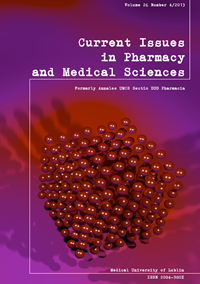Biochemical parameters of metabolic syndrome in type 2 diabetes patients: retrospective study
DOI:
https://doi.org/10.12923/j.2084-980X/26.4/a.18Keywords:
metabolic syndrome, diabetes type 2, lipids, glycated hemoglobin HbA1C, WHO and NCEP:ATPIII classificationAbstract
Metabolic syndrome is one of the most important problems of public health in developed societies. A constant interest in this issue is caused by a wide spread of this problem and the lack of uniform diagnostic criteria. The variety of functioning definitions make fast algorithm difficult for a diagnostician, thus the aim of this study was to check the relationship between presence of selected biochemical indicators of metabolic syndrome in a large group of patients with diabetes type 2, and the differences in the course of the disease and degree of compensation. For this comparison, we have used World Health Organization and the National Cholesterol Education Program Adult Treatment Panel III criteria of metabolic syndrome. The studies were performed among 1079 patients with diagnosed diabetes type 2. It is worthwhile that triglycerides elevation in diabetic patients could be treated as a sensitive and specific indicator of metabolic syndrome presence even without evaluation of other features. This observation finds intermediate confirmation also in our study; however, future studies are needed to examine the significance of metabolic syndrome following all criteria for the assessment of risk for diabetes and/or cardiovascular disease.
References
1. Alberti K. G., Zimmet P.Z. : Definition, diagnosis and classification of diabetes mellitus and its complications. Part 1: diagnosis and classification of diabetes mellitus provisional report of a WHO consultation. Diabet. Med., 15, 1998.
2. Alrefai H., Allababini H., Levy S. et al.: The endocrine system in diabetes mellitus. Endocrine, 18(2), 2002.
3. Arslanian S., Suprasongsin C.: Insulin sensivity, lipids, and body composition in childhood: is “syndrome X” present? J Clin. Endocrinol. Metab., 81(3), 1996.
4. Banerji M. A., Lebovitz J., Chaiken R. L. et al.: Relationship of visceral adipose tissue and glucose disposal in independent of sex in black NIDDM subjects. Am J Physiol., 273, 1997.
5. Chlebus D., Kaznowska-Bystryk I., Lewandowska-Stanek H.: Occurrence of metabolic syndrome in hospitalized patients with type 2 diabetes – a retrospective epidemiological study. MONZ, 17(2), 2011.
6. Costa L. A., Canani L. H., Lisboa H. R. et al.: Aggregation of features of the metabolic syndrome is associated with increased prevalence of chronic complications in type 2 diabetes. Diabet. Med., 21(3), 2004.
7. De Fronzo R. A.: The metabolic-cardiovascular syndrome: insulin resistance, hyperinsulinemia, coronary artery disease, hypertension and dyslipiemia. Progr. Diab., 4:1, 1992.
8. Einhorn D., Reaven G. M., Cobin R. H., et al.: American College of Endocrinology position statement on the insulin resistance syndrome. Endocr. Pract., 9, 2003.
9. Executive Summary of The Third Report of The National Cholesterol Education Program (NCEP) Expert Panel on Detection, Evaluation, And Treatment of High Blood Cholesterol In Adults (Adult Treatment Panel III). JAMA, 285, 2001.
10. Galassi A., Reynolds K., He J.: Metabolic syndrome and risk of cardiovascular disease: a meta-analysis. Am J Med., 119(10), 2006.
11. Grundy S. M., Brewer H. B., Cleeman Jr. J. J. et al.: Definition of Metabolic Syndrome: Report of the National Heart, Lung, and Blood Institute/American Heart Association Conference on Scientific Issues Related to Definition. Circulation, 27, 2004.
12. Hunt K. J., Resendez R. G., Williams K. et al.: National Cholesterol Education Program Versus World Health Organization Metabolic Syndrome in Relation to All-Cause and Cardiovascular Mortality in the San Antonio Heart Study. Circulation, 110, 2004.
13. Kassi E., Pervanidou P., Kaltsas G. et al.: Metabolic syndrome: definitions and controversies. BMC Medicine, 9:48, 2011.
14. Khan M. A., Collins A. J., Keane W. F.: Diabetes in the elderly population. Adv. Ren. Replace. Ther., 7(1), 2000.
15. Kompoti M., Mariolis A., Alevizos A. et al.: Elevated serum triglycerides is the strongest single indicator for the presence of the metabolic syndrome in patients with type 2 diabetes. Cardiovasc. Diabetol. 5:21, 2006.
16. Merino-Ibarra E., Cenarro A., Martin P. et al.: Sensivity and specificity of metabolic syndrome criteria for insulin resistance diagnosis in Spanish population. Med. Clin. (Barc), 128(5), 2007.
17. Moy F. M, Bulgiba A.: The modified NCEP ATP III criteria maybe better than the IDF criteria in diagnosing Metabolic Syndrome among Malays in Kuala Lumpur. BMC Public Health, 10:678, 2010.
18. Nesto R. W.: Beyond low-density lipoprotein: addressing the atherogenic lipid triad in type diabetes mellitus and the metabolic syndrome. Am J Cardiovasc. Drugs, 5(6), 2005.
19. Picon P. X., Zanatta C.M., Gerchman F.: Analysis of the criteria used for the definition of metabolic syndrome in patients with type 2 diabetes mellitus. Arq. Bras. Endocrinol. Metabol., 50(2), 2006.
20. Reaven G. M. : Banting lecture 1988. Role of insulin resistance in human disease. Diabetes, 37, 1988.
21. Sieradzki J.: Zespół metaboliczny (zespół X). Diag. Lab., 29, 1993.
22. Suleyman A., Aziz A., Suna A. et al.: Today’s and yesterday’s of pathophysiology: Biochemistry of metabolic syndrome and animal models. Nutrition, 30, 1-9, 2014.
23. Takamiya T., Zaky W. R., Edmundowics D., et al.: World Health Organization–Defined Metabolic Syndrome Is a Better Predictor of Coronary Calcium Than the Adult Treatment Panel III Criteria in American Men Aged 40–49 Years. Diabetes Care, 27(12), 2004.
Downloads
Published
Issue
Section
License
Copyright (c) 2013 Authors

This work is licensed under a Creative Commons Attribution-NonCommercial-NoDerivatives 3.0 Unported License.


